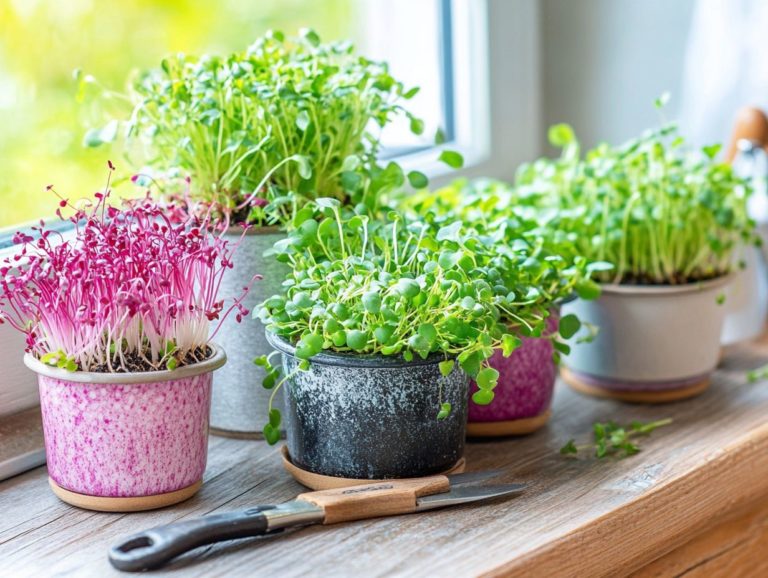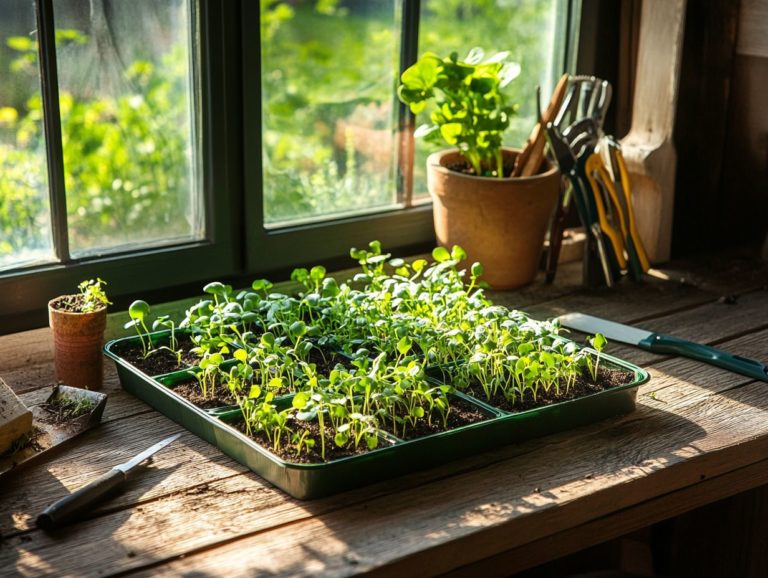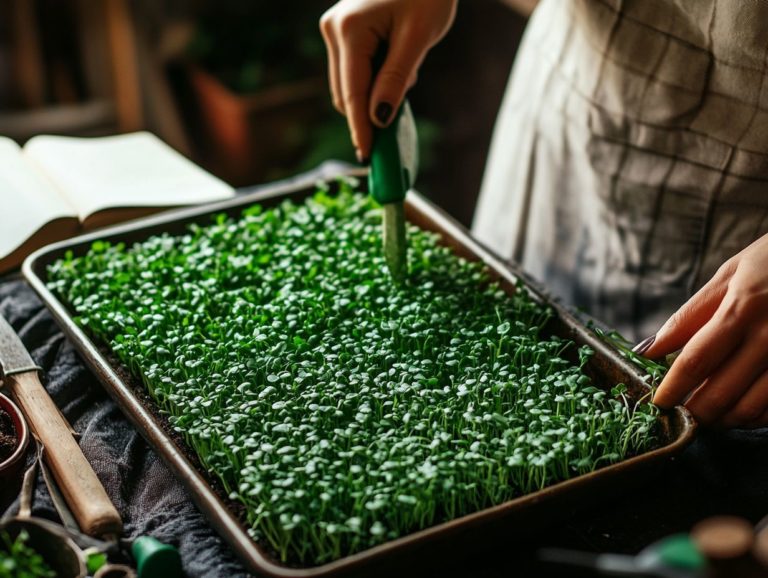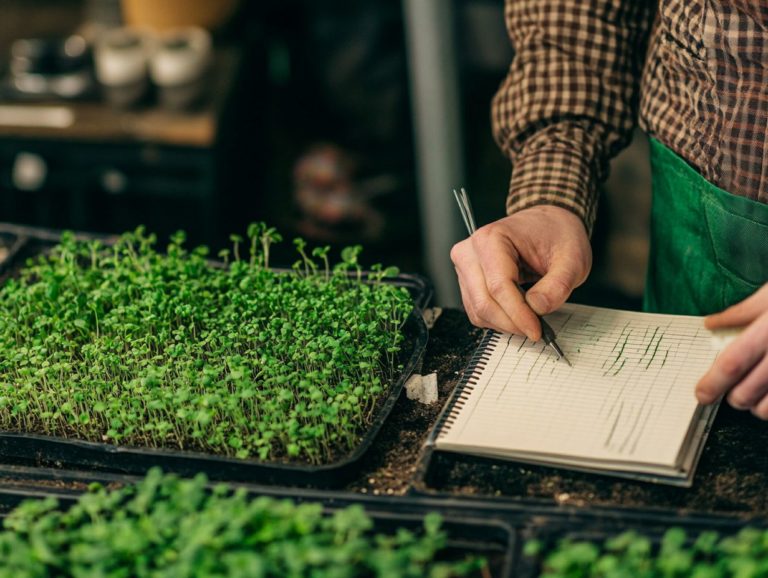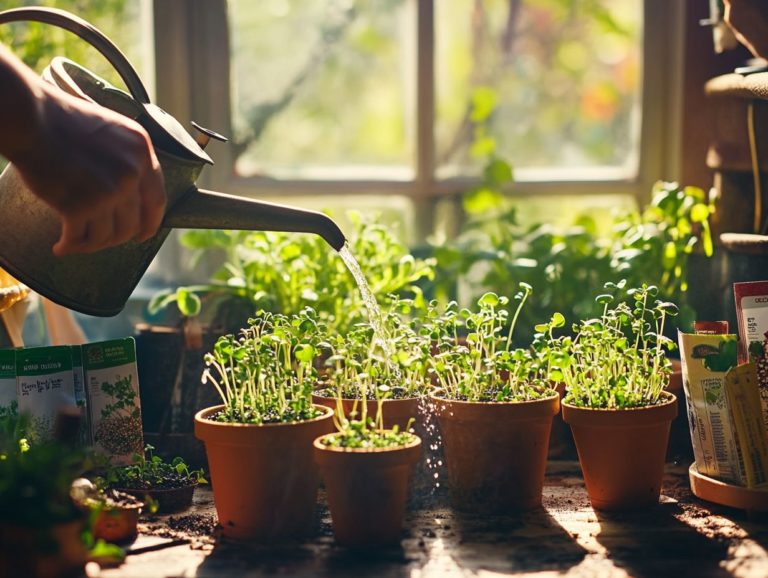Timing Your Microgreens: When to Harvest?
Microgreens are tiny, nutrient-rich plants. They add both flavor and health benefits to your meals.
Whether you’re an experienced gardener or a cooking enthusiast, learning to grow and harvest these greens can elevate your nutrition.
This article delves into the myriad advantages of microgreens, highlighting their remarkable nutritional profile and versatile culinary applications.
You ll discover key factors that influence harvest time, learn how to recognize signs of readiness, and explore effective methods for harvesting and storing your microgreens.
Dive into the exciting world of microgreens! These miniature greens can transform your meals and boost your health.
Contents
- Key Takeaways:
- Benefits of Growing and Harvesting Microgreens
- Factors Affecting Microgreen Harvest Time
- Signs of Readiness for Harvesting
- How to Harvest Microgreens
- Storing and Using Harvested Microgreens
- Frequently Asked Questions
- When is the best time to harvest microgreens?
- How do I know if my microgreens are ready to be harvested?
- Can I harvest my microgreens too early?
- What happens if I wait too long to harvest my microgreens?
- Should I harvest all my microgreens at once or can I do it in stages?
- How do I store harvested microgreens?
Key Takeaways:
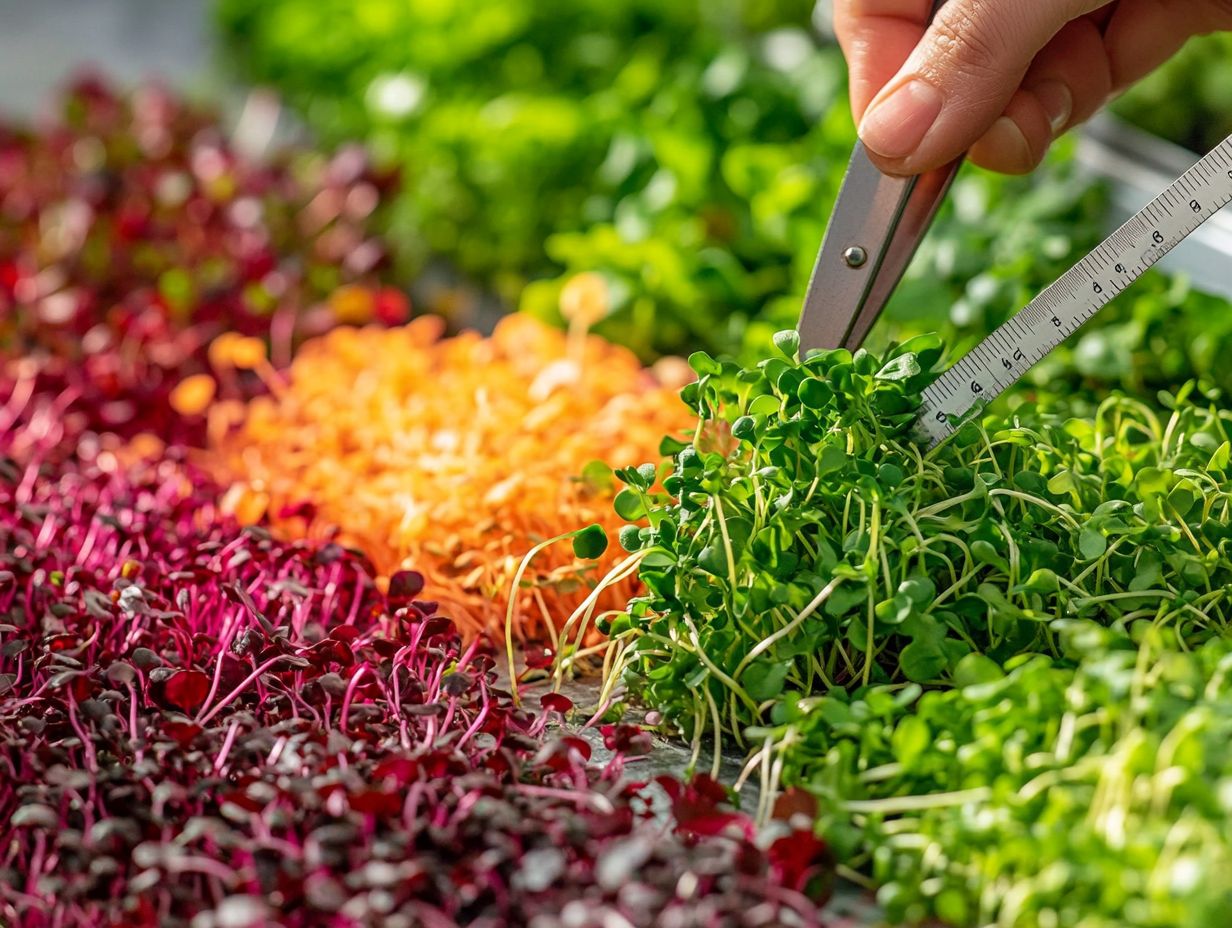
- Harvest microgreens when they are at their peak nutritional value and flavor, usually around 7-14 days after germination.
- Pay attention to environmental factors such as light, temperature, and humidity to ensure optimal growth and timing for harvesting.
- Use visual and tactile cues, as well as proper techniques and tools, to harvest microgreens properly without damaging the delicate plants.
What are Microgreens?
Microgreens are young, edible plants harvested at the early leaf stage, just after the first true leaves appear. These vibrant greens think Arugula, Broccoli, and Radish are cultivated for their rich flavor and delightful texture, making them a must-have in your culinary repertoire.
As urban farming and home gardening rise in popularity, these tiny powerhouses are not just a trend; they re also a treasure trove of health benefits, delivering concentrated nutrients in a compact form.
Unlike their mature counterparts, which take months to grow, microgreens typically reach harvest-ready status in just 7 to 21 days, depending on the variety. This rapid growth cycle means you can enjoy a quick turnaround in your kitchen or garden while ensuring these greens retain maximum nutrients.
You ll find an impressive array of vitamins A, C, E, and K as well as essential minerals like calcium and iron packed into these little wonders.
Some crowd-pleasers, like Beet Greens and Pea Shoots, offer unique flavors and textures that can transform your dishes. Whether tossed into salads, layered in sandwiches, or used as eye-catching garnishes, their vibrant colors and bold tastes can elevate any plate while significantly contributing to your overall health.
Benefits of Growing and Harvesting Microgreens
Growing microgreens offers numerous benefits. They are perfect for urban farming and home gardening. The health advantages linked to these nutrient-rich crops are considerable, as they deliver essential vitamins and minerals vital for a balanced diet.
Harvested just days after germination, microgreens ensure maximum freshness and flavor, elevating your culinary experiences to new heights.
Nutritional Value and Culinary Uses
Microgreens are not just a culinary trend; they re a powerhouse of flavor and nutrition that deserves a spot in your kitchen. Bursting with vitamins, antioxidants, and minerals, these tiny greens elevate your dishes both visually and nutritionally, adding a unique flavor and texture that transforms any meal into a gourmet experience.
Take broccoli microgreens, for instance. They pack a punch with high levels of sulforaphane, a compound celebrated for its potential cancer-fighting properties. On the other hand, cilantro microgreens bring a refreshing, citrusy zing that can brighten any dish and awaken your taste buds.
Imagine enriching your salads with these little gems, introducing a satisfying crunch and vibrant flavor. They make for fantastic sandwich toppings too, infusing your creations with nutrition and eye-catching color. When blended into smoothies, they offer an effortless way to boost nutritional value without overpowering the drink’s flavor.
Use them as garnishes, and you’ll not only enhance the aesthetic appeal of your plates but also elevate the overall dining experience by complementing both presentation and taste.
Start growing microgreens today and enjoy fresh, flavorful greens in just days!
Factors Affecting Microgreen Harvest Time
The harvest time for microgreens can vary significantly depending on several factors, such as germination rates, seeding rates, and environmental conditions like light and moisture. Understanding these factors can boost your microgreen harvest!
This attention to detail will enhance the flavor and texture of your culinary creations.
Types of Microgreens and Growth Rates
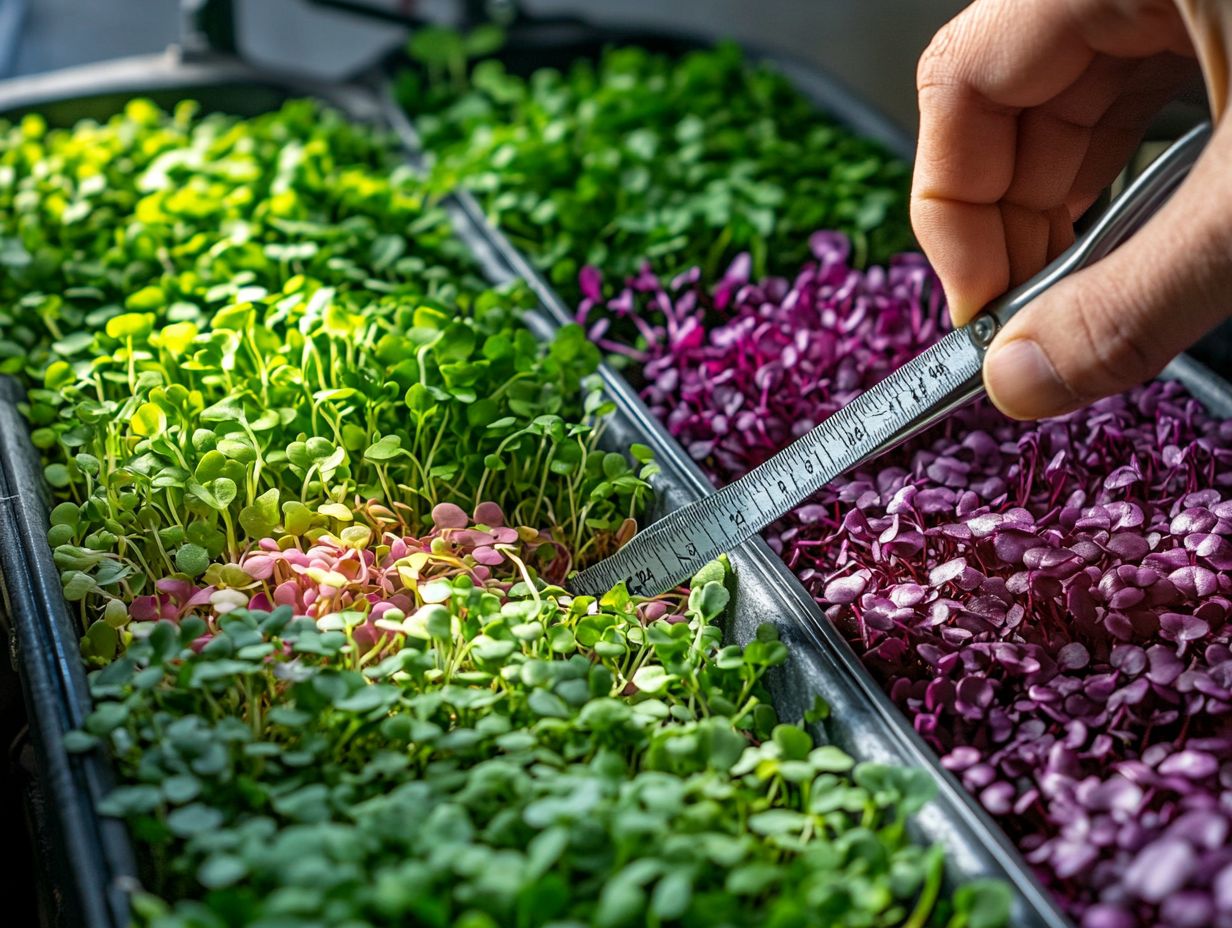
You ll find a fascinating array of microgreens, each boasting unique growth rates and characteristics. It s essential to familiarize yourself with popular varieties.
Whether you opt for the speedy Pea Shoots and Radish or the more leisurely Long Island Brussels sprout, understanding these growth rates will enable you to plan an efficient home gardening setup.
The diversity among microgreens extends beyond growth speed; it also encompasses their flavors, textures, and nutritional benefits.
For instance, sunflower microgreens mature quickly and are loaded with beneficial nutrients, while beet microgreens bring an earthy taste that can elevate your salads and dishes.
To cultivate these tiny greens successfully, sourcing seeds from reputable suppliers is crucial. Many offer organic and non-GMO options tailored for specific culinary uses.
Factors such as light exposure, moisture levels, and your choice of growing medium will significantly impact their growth. Paying attention to these details will be vital for achieving the best harvest possible.
Environmental Factors
Environmental factors are essential for the successful growth of microgreens, with light conditions being the most critical element in their development. Choosing optimal growing media, such as hydroponic soil and other substrates, significantly impacts the health and efficiency of these nutrient-rich crops.
The intensity and duration of light exposure directly affect germination and the overall vigor of your plants. Most microgreens thrive in a warm environment, ideally between 65 and 75 degrees Fahrenheit, which encourages rapid growth. To ensure optimal results, it’s important to learn about Understanding Microgreen Growth Cycles.
Humidity levels also play a vital role in moisture retention within your growing environment, so monitoring and adjusting them is key. Selecting the right growing media can greatly enhance your results; for example, hydroponics offers a soilless alternative that can lead to faster maturation and better yields.
By implementing these strategies, you can ensure a bountiful harvest, maximizing the health benefits of these tiny greens.
Signs of Readiness for Harvesting
Recognizing the signs that indicate your microgreens are ready for harvesting is crucial for maximizing both their flavor and nutritional content. Pay close attention to visual cues, such as the emergence of true leaves and achieving the right height.
Tactile cues, like a firm texture, will also guide you in determining the perfect time to harvest.
Visual and Tactile Cues
Identifying visual and tactile cues is essential for determining when to harvest microgreens for maximum flavor and nutrition.
Look for vibrant leaf color and size. A gentle touch can reveal firmness and readiness.
The vibrancy of a microgreen’s hue can indicate its nutritional value; brighter greens often pack higher levels of vitamins. Similarly, the shape of the leaves can hint at the specific variety and its optimal growth stage.
Taller varieties should stand proudly upright without drooping, while shorter ones might present a lush, compact appearance. A gentle squeeze of the leaves can reveal their moisture content and tenderness, signaling when they are at their peak.
By incorporating these straightforward yet effective techniques, you can effortlessly gauge the readiness of your microgreens, ensuring a flavorful and nutritious harvest every time.
Start your microgreen journey now and enjoy flavorful, nutritious greens at home!
How to Harvest Microgreens
Harvesting microgreens demands a refined approach. Employ the right techniques and tools to minimize any harm to these delicate plants while optimizing yield.
Use sharp scissors or specialized harvesting tools to efficiently snip the microgreens at their base. This preserves their integrity for continued growth and guarantees a fresh product for your culinary endeavors. For more detailed information, refer to our guide on understanding microgreen harvest timing.
Proper Techniques and Tools
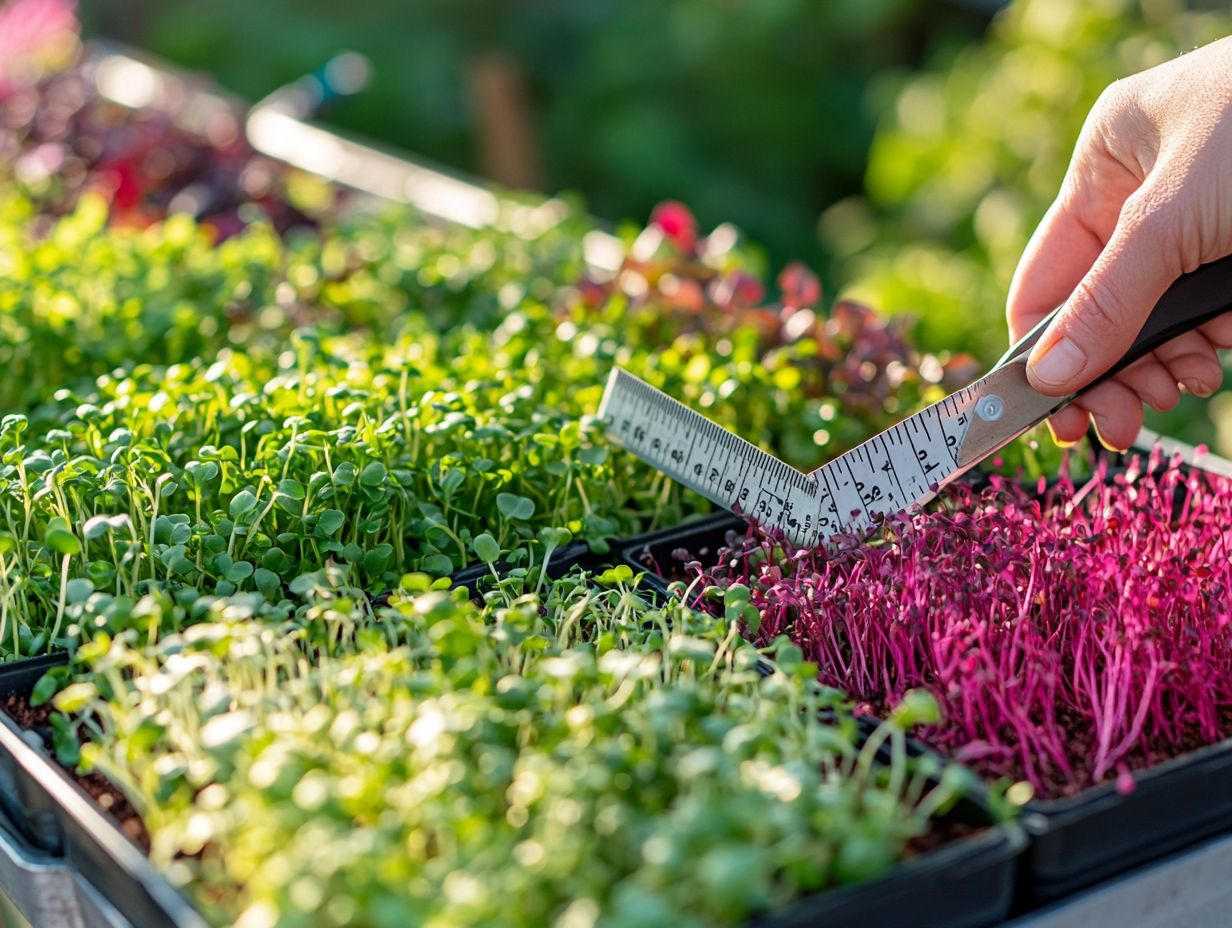
Using the right techniques and tools is crucial for harvesting microgreens. It helps you achieve a clean cut while minimizing damage to the plants.
Opt for sharp scissors, knives, or specialized harvesting tools to make the process efficient and effective. These tools enhance your precision and maintain the integrity of the delicate microgreens.
Creating a clean harvesting area is vital. Contaminants can compromise the flavor and safety of your greens. Remember to sanitize all equipment before use to eliminate any risk of transferring germs.
Investing in specialized harvesting tools designed specifically for microgreens offers added advantages, such as an ergonomic grip and a gentle touch. Taking care of these tools, including regular cleaning and safe storage, ensures they stay in top condition, allowing you to achieve the best possible yield.
Storing and Using Harvested Microgreens
Carefully storing and using your harvested microgreens is essential for keeping their fresh flavor and vibrant appearance. This ensures they remain a vibrant enhancement to your meals.
Employ effective preservation techniques to significantly extend their shelf life. Explore creative recipes to elevate their culinary potential. This allows you to fully appreciate these delightful greens in your cooking.
Preservation Methods and Recipe Ideas
You can use several effective preservation methods to keep your harvested microgreens fresh. This ensures they are always ready for various culinary applications.
- Refrigerate in breathable containers to keep them crisp and nutrient-rich for days.
- Consider freezing them to preserve their vibrant colors and essential nutrients ideal for smoothies or soups. Just remember to blanch them first.
- While less common, drying can create unique seasonings that pack a flavorful punch.
With their adaptability, microgreens can inspire an array of recipes, from vibrant pesto and refreshing juices to delectable tacos, all while delivering a significant boost of vitamins and minerals.
Frequently Asked Questions
When is the best time to harvest microgreens?
The best time to harvest microgreens is when they reach the peak of their growth, usually around 7-14 days after germination.
How do I know if my microgreens are ready to be harvested?

You can tell if your microgreens are ready by looking at the size and color of the leaves. They should be fully grown with vibrant colors.
Can I harvest my microgreens too early?
Yes, harvesting microgreens too early can lead to a smaller yield and less intense flavor. Wait until they have reached peak growth before harvesting.
What happens if I wait too long to harvest my microgreens?
If you wait too long, they may become too tall and tough, making them difficult to eat. It’s best to harvest when they are at their prime.
Should I harvest all my microgreens at once or can I do it in stages?
You can harvest your microgreens in stages, especially if you have a large batch. This will ensure they stay fresh longer, allowing you to enjoy them at different growth stages.
Try these methods today, and let your meals shine with fresh microgreens!
How do I store harvested microgreens?
To keep your harvested microgreens fresh and tasty, store them in an airtight container in the refrigerator right away!
Although they can last up to a week, enjoy them as soon as possible to savor their best flavor. Microgreens are young plants harvested just after the first leaves have developed.

